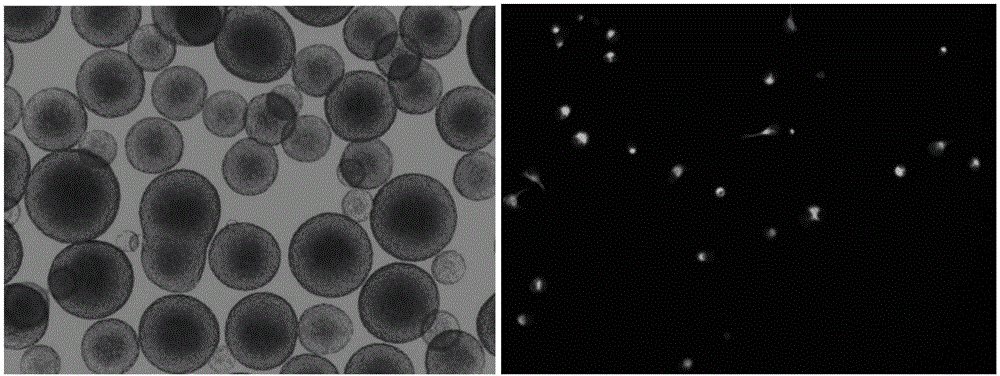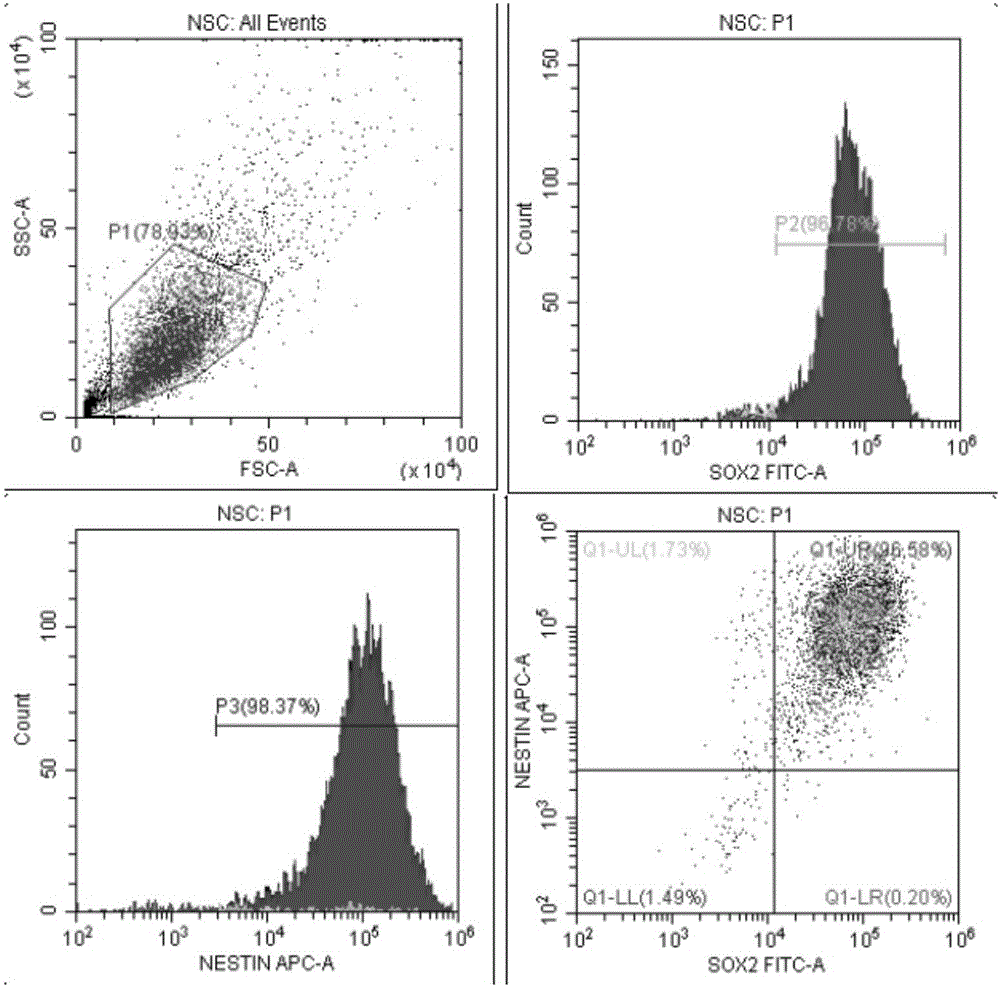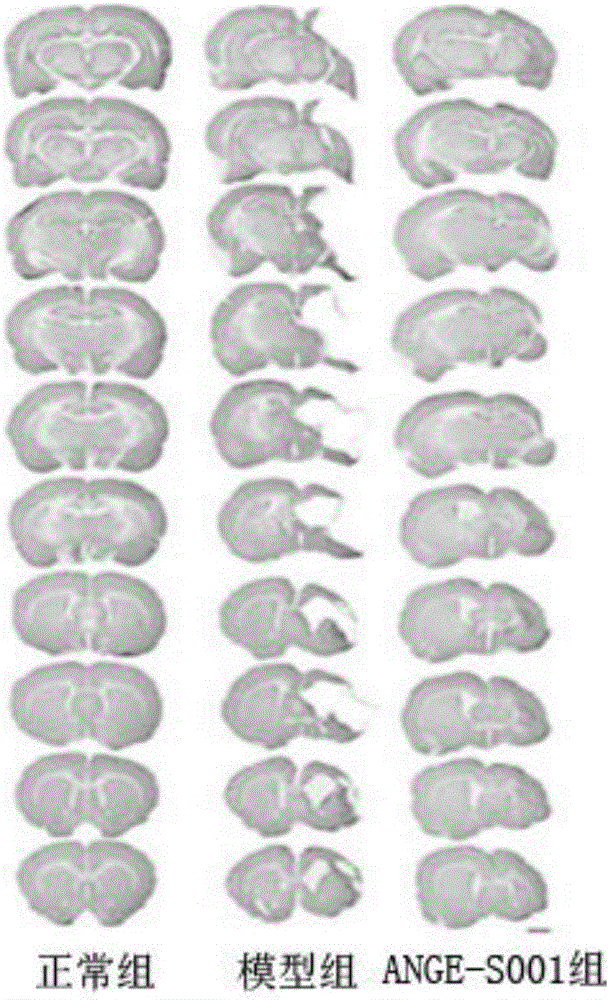Neural stem cell injection for treating brain damage disease
A technology of neural stem cells and brain injury, applied in the direction of nervous system cells, animal cells, nervous system diseases, etc., can solve the problems of no specific treatment for children with cerebral palsy, can not achieve treatment, etc., achieve good stemness and differentiation potential, in vitro The effect of strong amplification ability
- Summary
- Abstract
- Description
- Claims
- Application Information
AI Technical Summary
Problems solved by technology
Method used
Image
Examples
Embodiment 1
[0052] Example 1: Preparation of primary neural stem cells
[0053] 1. Induction of primary neural stem cells from embryonic stem cells (ESCs)
[0054] Use a cell scraper to pick ESCs cell clones, blow them gently, and then resuspend them with neural stem cell induction medium, transfer them to an ultra-low adsorption culture dish for suspension culture for about 3 days, collect the formed cell balls, blow them gently, and then use neural stem cell The stem cell induction medium was resuspended, suspended and cultured in an ultra-low adsorption culture dish for 3 days, and the formed cell spheres were collected; the culture dish coated with Laminin was washed twice with DPBS without Ca and Mg one day in advance, and the collected The cell balls were resuspended with the complete medium of neural stem cells, inoculated in the coated culture dish for adherent culture, and the medium was changed every 2-3 days until obvious neural-like colonies were formed, and then the formed ce...
Embodiment 2
[0068] Example 2: Preparation of P1-P5 generation neural stem cells
[0069] 1. Passage and culture of primary neural stem cells
[0070] Inject the prepared 10ml sterile neural digestion solution into the centrifuge tube containing the primary neural stem cell spheres with a sterile syringe. Seal the mouth of the centrifuge tube with parafilm and let stand for 3 minutes. Add the prepared sterilized nerve tissue digestion solution, put it into a carbon dioxide incubator at 35°C for 30 minutes (manually shake for 5 seconds every 10 minutes). Low-temperature centrifuge at 4°C, 300g, and centrifuge for 10 minutes. Discard the supernatant with a sterile disposable pipette, add 1-5mL DMEM / F12 to rinse with a high-power pipette and pipette, and blow up and down 2-3 times to separate the tissue. Low-temperature centrifuge at 4°C, 300g, and centrifuge for 10-20 minutes. Add 1-5mL hibernation medium again for washing, and wash three times in total. Discard the supernatant with a s...
Embodiment 3
[0091] Example 3 Preparation of P6-P9 generation neural stem cells
[0092] 1. Recovery of cells
[0093] Take out the frozen cells from the liquid nitrogen tank, put them on the resuscitation rack in the electric heating constant temperature water tank (the water temperature is kept at about 40 ℃), shake quickly to rewarm. Resuscitation is complete when the solid changes to a liquid.
[0094] 1.1 Cell washing
[0095] Seal the mouth of the centrifuge tube with parafilm and let stand for 3 minutes. Add the prepared sterilized nerve tissue digestion solution, put it into a carbon dioxide incubator at 35°C for 5-60 minutes (manually shake for 5 seconds every 10 minutes). Low-temperature centrifuge at 4°C, 300g, and centrifuge for 10 minutes.
[0096] 1.2 Sampling counting and washing
[0097] Discard the supernatant with a sterile disposable pipette, add 1-10mL DMEM / F12 to rinse with a high-power pipette and pipette, and blow up and down 2-3 times to separate the tissue. L...
PUM
 Login to View More
Login to View More Abstract
Description
Claims
Application Information
 Login to View More
Login to View More - R&D
- Intellectual Property
- Life Sciences
- Materials
- Tech Scout
- Unparalleled Data Quality
- Higher Quality Content
- 60% Fewer Hallucinations
Browse by: Latest US Patents, China's latest patents, Technical Efficacy Thesaurus, Application Domain, Technology Topic, Popular Technical Reports.
© 2025 PatSnap. All rights reserved.Legal|Privacy policy|Modern Slavery Act Transparency Statement|Sitemap|About US| Contact US: help@patsnap.com



